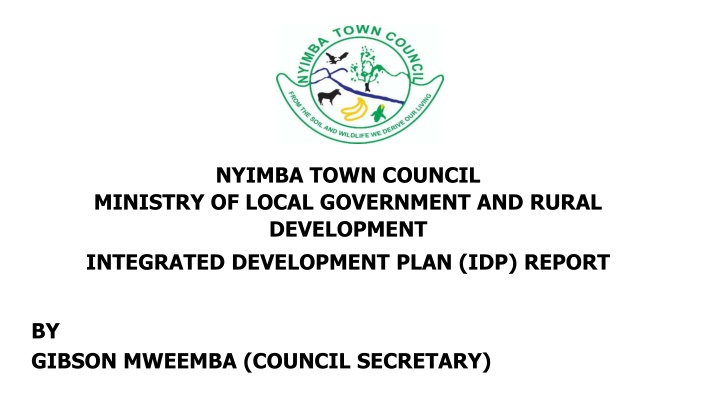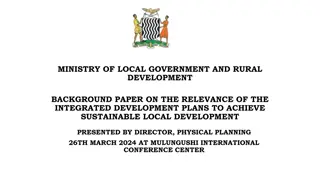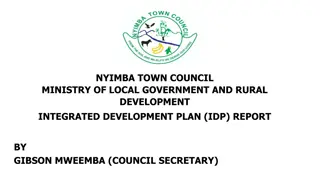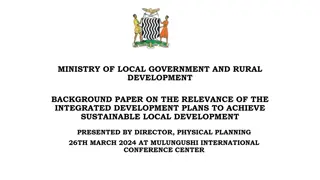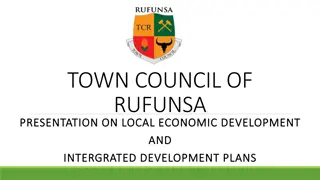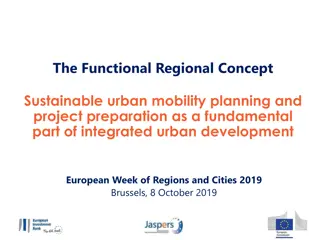Integrated Development Planning: Ensuring Sustainable Progress in Local Governance
An Integrated Development Plan (IDP) serves as a framework for coordinated development efforts, aiming to improve the quality of life in an area by involving local authorities, government departments, and development partners. Legal requirements, funding sources, disaster management, and challenges faced by local authorities in IDP implementation are discussed. The sustainability of IDPs relies on effective governance, community participation, and feedback mechanisms to ensure inclusive and impactful development initiatives.
Download Presentation

Please find below an Image/Link to download the presentation.
The content on the website is provided AS IS for your information and personal use only. It may not be sold, licensed, or shared on other websites without obtaining consent from the author.If you encounter any issues during the download, it is possible that the publisher has removed the file from their server.
You are allowed to download the files provided on this website for personal or commercial use, subject to the condition that they are used lawfully. All files are the property of their respective owners.
The content on the website is provided AS IS for your information and personal use only. It may not be sold, licensed, or shared on other websites without obtaining consent from the author.
E N D
Presentation Transcript
NYIMBA TOWN COUNCIL MINISTRY OF LOCAL GOVERNMENT AND RURAL DEVELOPMENT INTEGRATED DEVELOPMENT PLAN (IDP) REPORT BY GIBSON MWEEMBA (COUNCIL SECRETARY)
PRESENTATION OUTLINE INTRODUCTORY LEGAL REQUIREMENTS CAN DISTRICTS MULTISECTORAL INTEGRATED APPROACH). SOURCES OF FUNDING FOR PREPARATION AND IMPLEMENTATION OF IDPS. LOCAL AUTHORITY REACTION TO DISASTERS, MANGEMENT OF DISASTER, EXPERIENCES AND RECOMMENDATIONS. CHALLENGES FACED BY THE LOCAL AUTHORITIES IN THE DEVELOPMENT AND IMPLEMENTATION OF THE INTEGRATED DEVELOPMENT PLANS. SUSTAIN THE IDPS? (PREPARATION PROCESS AND
INTRODUCTORY An Integrated Development Plan (IDP) is a plan for an area that gives an overall framework for development. It aims to co-ordinate the works of the Local Authority with Government Departments and other Development Partners in a coherent manner to improve the quality of life for all the people living in an area. The District Integrated Development Plan therefore, helps the Local Authority to focus on the immediate and most important local needs by taking into account the resources available in the community. The IDP helps speed up service delivery in the most efficient and effective manner to the most impoverished areas without leaving anyone behind. It helps to attract additional funds, strengthen democracy through active participation of all the key stakeholders.
LEGAL REQUIREMENTS The IDP Preparation and Implementation is governed by two (2) main Acts namely the Urban and Regional Planning Act No. 3 of 2015 and National Planning and Budgeting Act No. 1 of 2022. The Urban and Regional Planning Act No. 3 of 2015 demands that, Local Authorities prepare IDPs programmes and activities with other Developmental Agencies. The National Planning and Budgeting Act No. 1 of 2020 provides Local Development Plan means a five-year plan for implementation of the National Development Plan, integrated development plan, sector investment plan and Medium-Term Budget Plan at district level. In addition, this development plan that consists of the national vision, investment plans and the integrated development plans of each district and is valid for a period of more than five years. to coordinate developmental
CAN DISTRICTS SUSTAIN THE IDPS? (PREPARATION PROCESS AND MULTISECTORAL INTEGRATED APPROACH) Can districts sustain the IDPS? multisectoral integrated approach) Answer: YES. (Preparation process and LOCAL AUTHORITY CAN SUSTAIN INTEGRATED DEVELOPMENT PLANS (IDPS) THROUGH EFFECTIVE OF THE FOLLOWING: Governance: Local Authority need to ensure that there are clear structures and processes in place for implementing and overseeing the IDPs. This includes having dedicated teams responsible for coordination, planning, and implementation of various projects outlined in the IDPs. Community Participation: Engaging preparation and implementation process is crucial for the sustainability of IDPs. Communities should be involved in identifying their needs, prioritizing projects, and providing implementation phase. local communities in the feedback throughout the
LOCAL AUTHORITY CAN SUSTAIN INTEGRATED DEVELOPMENT PLANS (IDPS) THROUGH EFFECTIVE OF FOLLOWING CONT : Resource Mobilization: Districts must explore various sources of funding to finance the projects outlined in the IDPs. This could include government budgets, partnerships, and community management is essential to ensure that resources are allocated efficiently and transparently. Capacity Building: Building the capacity of local government officials, community leaders, and other stakeholders is important for effective implementation and sustainability of IDPs. This could involve training programs on project management, budgeting, monitoring, and evaluation. grants, contributions. loans, public-private Effective financial
LOCAL AUTHORITY CAN SUSTAIN INTEGRATED DEVELOPMENT PLANS (IDPS) THROUGH EFFECTIVE OF FOLLOWING CONT : Monitoring and Evaluation: Continuous monitoring and evaluation of IDP projects are essential to track progress, identify challenges, and make necessary adjustments. Local authorities should establish robust monitoring and evaluation accountability and transparency in the implementation process. Adaptability: IDPs should be flexible enough to adapt to changing circumstances, such as shifts in demographics, economic conditions, or environmental factors. Regular reviews and updates of IDPs are necessary to ensure that they remain relevant and responsive to the needs of the communities they serve. mechanisms to ensure
IMPLEMENTATION OF THE IDPS (NYIMBA TOWN COUNCIL UTILIZED THE IDP INCLUDING PROJECTS)? IMPLEMENTATION OF IDP Budgetary Allocation Alignment: Adequate linkage between IDP programs and budgetary allocations has been done to ensure that their budgets correspond directly to the programs outlined in their IDPs. Enhanced stakeholder Participation: participation is very important in order change to the perception that IDPs are solely a council responsibility a situation which hampers effective implementation of programs contained therein. Consequently, councils has endeavored to engage all pertinent stakeholders and identify implementing partners within their districts to strengthen program implementation. enhanced stakeholder
IMPLEMENTATION OF THE IDPS (NYIMBA TOWN COUNCIL UTILIZED THE IDP INCLUDING IMPLEMENTATION OF IDP PROJECTS) CONT ? Engagement of Ward Development Committees (WDCs) and Constituency Development Fund Committees (CDFCs): Ward Development Committees (WDCs) and Constituency Development Fund Committees (CDFCs) play pivotal roles in project identification and selection on behalf of community members. Ideally, these committees should align their activities with the contents of IDPs. Hence, the local authority has engage and orient them to ensure that approved projects align with IDP objectives. Technical language in IDPs: The technical language used in IDPs poses challenges for ordinary citizens to comprehend and identify projects for implementation. Therefore, the council has developing simplified citizens versions of IDPs to enhance public understanding and involvement with the help of USAID Local Impact Project. consider
IMPLEMENTATION OF THE IDPS (NYIMBA TOWN COUNCIL UTILIZED THE IDP INCLUDING PROJECTS) CONT ? Engagement of Politicians: Members of Parliament and Councilors, as representatives of the community, should be acquainted with IDPs to align their development aspirations and promises with these strategic documents, thereby becoming advocates for implementation. IMPLEMENTATION OF IDP SOURCES IMPLEMENTATION OF IDPS. Government Government Equalization Fund/Grant. Donor World Bank and USAID. Cooperation Partners COMACO OF FUNDING FOR PREPARATION AND Constituency Development Fund and Local World Vision, Biocarbon Partners and
LOCAL AUTHORITY REACTION TO DISASTERS, MANGEMENT OF DISASTER, EXPERIENCES AND RECOMMENDATIONS. The local authority receives the notice for disaster from District Disaster Management Committee (DDMC) for onward processing. The local authority will constitute a team of engineers to inspect and prepare the bill of quantities (BOQ) for the said disaster. The local authority will prepare a report and BOQ submit to the Provincial Local Government Officer consideration. The matter will reported to CDF Committee to for reification. After the approval from the PLGO the LA will start the implementation of the Activities. The experience is that the best way to implement is disaster related activities expedite the approval process due to the nature of challenge. The recommendation is all disaster applications should be approved by the Council Secretary. (PLGO) for approval and
CHALLENGES FACED BY THE LOCAL AUTHORITIES IN THE DEVELOPMENT AND IMPLEMENTATION OF THE INTEGRATED The following are some of Challenges faced by Local Authorities in the development and implementation of the Integrated Development Plans: DEVELOPMENT PLANS. Inadequate financial Capacity (this is due to the fact that these IDP are very expensive to develop and implement) Poor road connectivity mostly in rural districts (this makes it hard for the IDP Team to reach some areas) Poor telecommunication network services (this makes it hard for IDP team to connect to the other areas mostly in rural areas) Limited Specialized Personnel that are equipped with specialized Geographical Information Services (GIS) knowledge in the district (this makes the process of formulating the IDP delaying) Inadequate capacity at the local level (WDCs, Zones and Villages) on planning skills.
RECOMMENDATIONS TO BE ADOPTED BY LOCAL AUTHORITIES IN THE DEVELOPMENT AND INTEGRATED DEVELOPMENT PLANS IMPLEMENTATION OF THE The following are some of recommendations for the way forward: Providing financial capital that matches the developing and implementation of IDP to the Local Authorities. Improving on road network system for easy access during the developing and implementation of the IDP. Improving telecommunication network services to improve connectivity during development and implementation of the IDP. Capacity building should be enhanced to ensure that the Local Authority personnel has latest advanced Geographical Information Services (GIS) knowledge with regards to IDP preparation and implementation. Capacity building of WDCs on how to develop Ward Development plans.
CONCLUSION The significance of Integrated Development Planning in facilitating meaningful community development in Zambia cannot be overstated. IDPs provide a comprehensive framework for district development, facilitating effective coordination, equitable resource allocation, and stakeholder participation. Consequently, Integrated Development authorities to manage scarce resources efficiently by prioritizing the most pressing needs of local communities. Planning enables local
